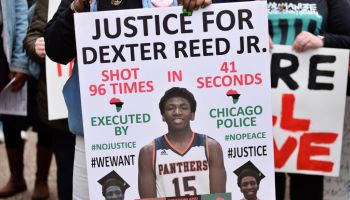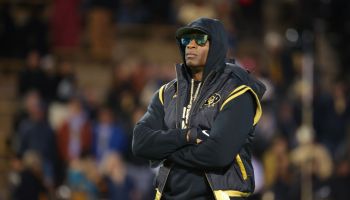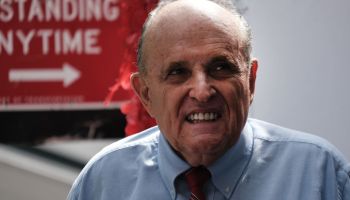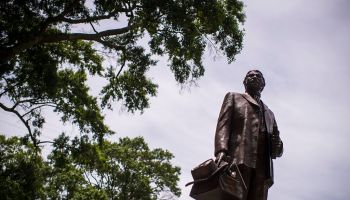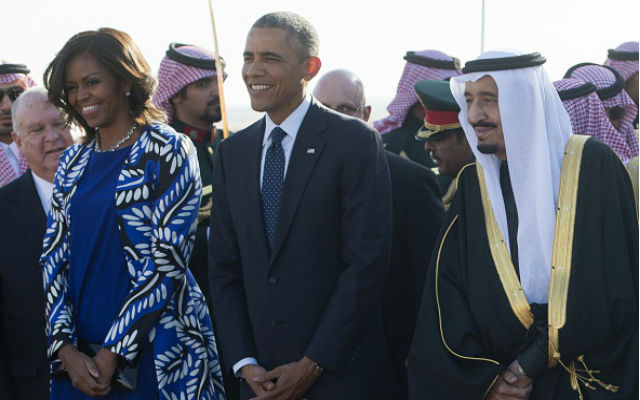
Saudi new King Salman walks alongside President Barack Obama and first lady Michelle Obama after the Obamas arrived on Air Force One at King Khalid International Airport in Riyadh on January 27, 2015. Obama landed in Saudi Arabia to shore up ties with King Salman and to offer condolences after the death of his predecessor Abdullah. (SAUL LOEB/AFP/Getty Images)
Michelle Obama’s absent headscarf on a visit with President Barack Obama to pay respects to the late Saudi King Abdullah Tuesday has sparked outrage among some members of the U.S. media, who called it disrespectful.
RELATED: First Lady Manages Strict Shariah Law In Saudi Arabia
The Associated Press reported Tuesday that the first lady did not wear a headscarf or veil, noting that it was an unusual move in Saudi Arabia because it’s one of the few countries on Earth where women are expected to cover their heads. The story went on to cite more than 1,500 tweets using the hashtag #ميشيل_أوباما_سفور (roughly, #Michelle_Obama_unveiled).
But Vox’s Max Fisher points out that the first lady was merely following in the footsteps of her White predecessors, who never experienced media backlash. Further, he notes that the controversy is fundamentally racist and “rooted in the idea that Arabs are such inherently backward cavemen that even top government leaders would somehow be shocked to see an unveiled woman.”
Vox reports:
-
American officials in Saudi Arabia typically do not wear headscarves, including at formal government functions. Michelle was following normal protocol.
-
Former first ladies Laura Bush and Hillary Clinton did not wear headscarves on similar official visits to Saudi Arabia. Neither did former Secretary of State Condoleezza Rice.
-
Saudi Arabia is officially ultra-conservative, but it is also heavily integrated into the global economy; unveiled Western women are extremely common in elite government circles like this one. Unveiled female Western leaders are common sights on Saudi media.
Vox also notes that Saudi’s twitterverse is rather large and the number of complaining social media users barely tips the scale toward a mass reaction.
Despite reports of a Saudi social media backlash against the first lady for going unveiled, tweets complaining about her appearance appear to have been quite limited. As the Wall Street Journal’s Ahmed Al Omran put it, “Saudi has millions of Twitter users. When a few hundred of them talk about something, that’s not a backlash. It’s hardly a flicker.”
The piece went on to slam social media users who seized the moment to promote stereotypes and Muslim fearmongering.
The American media’s assumption that Saudis are all cavemen whose faces would melt on seeing an unveiled woman is not just overly simplistic, but is rooted in racist assumptions about Arabs and Muslims as inherently and universally backwards. Unsurprisingly, many in the US have seized on this to perpetuate Islamophobic fearmongering about Muslims, such as when US Senator Ted Cruz tweeted, “Kudos to @FLOTUS for standing up for women & refusing to wear Sharia-mandated head-scarf in Saudi Arabia.”
If she had worn a headscarf, just imagine the momentum it would have given to the birther movement, Vox notes, citing an excerpt from a Facebook post by Nidal Diaz, an Ottowa-based analyst:
The unfortunate truth is that this had little to do with her making a stand for a woman’s right to not wear a veil and/or the Saudi government’s institutionalized sexism but more to do with attempting to avoid further perpetuating the American Right’s obsession for stigmatizing Obama and family as Muslims, and, approaching an election year, to prevent the Democrat administration from appearing to submit to the way of life of the vilified Saudis/Wahhabis. Beyond that, I highly doubt that whatever vitriol she got on Saudi social media and blogosphere would have even compared to the backlash she would have gotten had she been pictured wearing a veil at Abdullah’s funeral.
Vox notes that in its rush to find fault with the first lady, the media ended up focusing on the wrong issues:
The Saudi government is indeed a despotic dictatorship and horrific human rights abuser — it has beheaded three people in the week since the king died — particularly when it comes to women. It is unfortunate and ironic that, in an attempt to highlight this problem, much of the American media has instead only perpetuated the different but very real American problem of Islamophobic and anti-Arab stereotyping.
Indeed, this is not an issue about the absence of the first lady’s headscarf, but a push to find fault where there is none to avoid tackling weightier matters like human rights abuses.
Stay strong, first lady Obama!
SEE ALSO: Marissa Alexander Released, Must Pay For Her Own Electronic Monitoring













